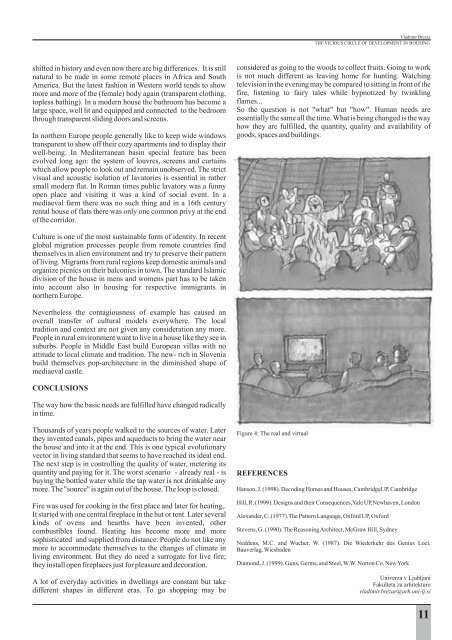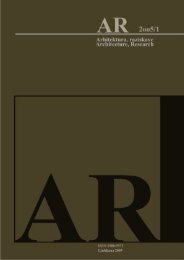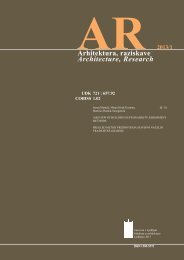2oo2/1 - Fakulteta za arhitekturo - Univerza v Ljubljani
2oo2/1 - Fakulteta za arhitekturo - Univerza v Ljubljani
2oo2/1 - Fakulteta za arhitekturo - Univerza v Ljubljani
Create successful ePaper yourself
Turn your PDF publications into a flip-book with our unique Google optimized e-Paper software.
shifted in history and even now there are big differences. It is still<br />
natural to be nude in some remote places in Africa and South<br />
America. But the latest fashion in Western world tends to show<br />
more and more of the (female) body again (transparent clothing,<br />
topless bathing). In a modern house the bathroom has become a<br />
large space, well lit and equipped and connected to the bedroom<br />
through transparent sliding doors and screens.<br />
In northern Europe people generally like to keep wide windows<br />
transparent to show off their cozy apartments and to display their<br />
well-being. In Mediterranean basin special feature has been<br />
evolved long ago: the system of louvres, screens and curtains<br />
which allow people to look out and remain unobserved. The strict<br />
visual and acoustic isolation of lavatories is essential in rather<br />
small modern flat. In Roman times public lavatory was a funny<br />
open place and visiting it was a kind of social event. In a<br />
mediaeval farm there was no such thing and in a 16th century<br />
rental house of flats there was only one common privy at the end<br />
of the corridor.<br />
Culture is one of the most sustainable form of identity. In recent<br />
global migration processes people from remote countries find<br />
themselves in alien environment and try to preserve their pattern<br />
of living. Migrants from rural regions keep domestic animals and<br />
organize picnics on their balconies in town. The standard Islamic<br />
division of the house in mens and womens part has to be taken<br />
into account also in housing for respective immigrants in<br />
northern Europe.<br />
Nevertheless the contagiousness of example has caused an<br />
overall transfer of cultural models everywhere. The local<br />
tradition and context are not given any consideration any more.<br />
People in rural environment want to live in a house like they see in<br />
suburbs. People in Middle East build European villas with no<br />
attitude to local climate and tradition. The new- rich in Slovenia<br />
build themselves pop-architecture in the diminished shape of<br />
mediaeval castle.<br />
CONCLUSIONS<br />
The way how the basic needs are fulfilled have changed radically<br />
in time.<br />
Thousands of years people walked to the sources of water. Later<br />
they invented canals, pipes and aqueducts to bring the water near<br />
the house and into it at the end. This is one typical evolutionary<br />
vector in living standard that seems to have reached its ideal end.<br />
The next step is in controlling the quality of water, metering its<br />
quantity and paying for it. The worst scenario - already real - is<br />
buying the bottled water while the tap water is not drinkable any<br />
more. The "source" is again out of the house. The loop is closed.<br />
Fire was used for cooking in the first place and later for heating,.<br />
It started with one central fireplace in the hut or tent. Later several<br />
kinds of ovens and hearths have been invented, other<br />
combustibles found. Heating has become more and more<br />
sophisticated and supplied from distance. People do not like any<br />
more to accommodate themselves to the changes of climate in<br />
living environment. But they do need a surrogate for live fire;<br />
they install open fireplaces just for pleasure and decoration.<br />
A lot of everyday activities in dwellings are constant but take<br />
different shapes in different eras. To go shopping may be<br />
Vladimir Bre<strong>za</strong>r<br />
THE VICIOUS CIRCLE OF DEVELOPMENT IN HOUSING<br />
considered as going to the woods to collect fruits. Going to work<br />
is not much different as leaving home for hunting. Watching<br />
television in the evening may be compared to sitting in front of the<br />
fire, listening to fairy tales while hypnotized by twinkling<br />
flames...<br />
So the question is not "what" but "how". Human needs are<br />
essentially the same all the time. What is being changed is the way<br />
how they are fulfilled, the quantity, quality and availability of<br />
goods, spaces and buildings.<br />
Figure 4: The real and virtual<br />
REFERENCES<br />
Hanson, J. (1998). Decoding Homes and Houses, CambridgeUP, Cambridge<br />
Hill, R. (1999). Designs and their Consequences,Yale UP,Newhaven, London<br />
Alexander, C. (1977).The Pattern Language, Oxford UP, Oxford<br />
Stevens, G. (1990). The ReasoningArchitect, McGraw Hill, Sydney<br />
Neddens, M.C. and Wucher, W. (1987). Die Wiederkehr des Genius Loci,<br />
Bauverlag, Wiesbaden<br />
Diamond, J. (1999). Guns, Germs, and Steel, W.W. Norton Co. NewYork<br />
Univer<strong>za</strong> v <strong>Ljubljani</strong><br />
<strong>Fakulteta</strong> <strong>za</strong> <strong>arhitekturo</strong><br />
vladimir.bre<strong>za</strong>r@arh.uni-lj.si<br />
11

















